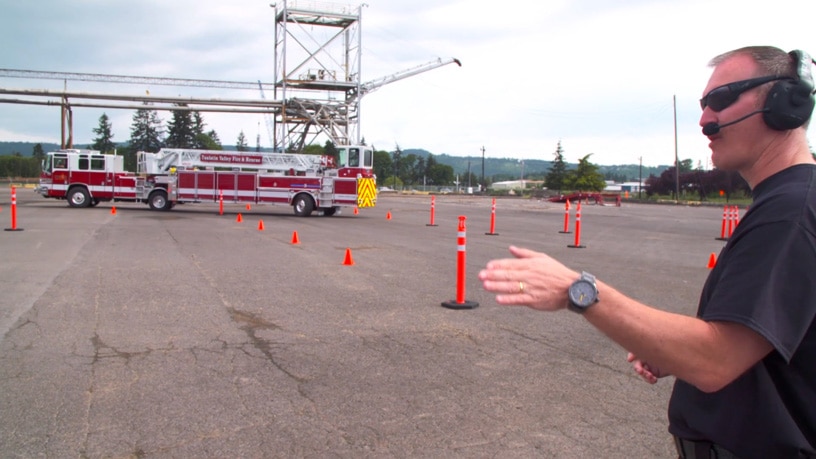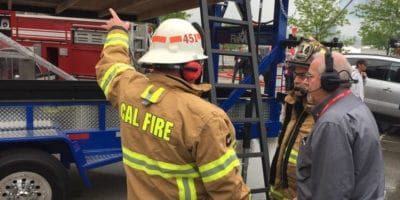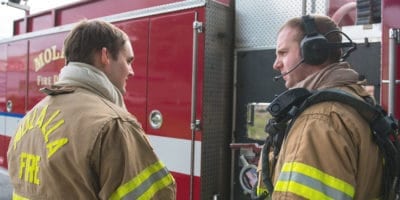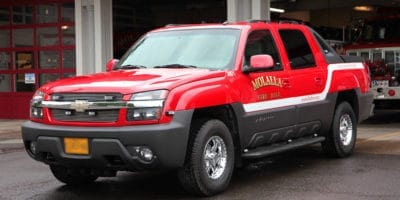Best Practices in Tractor-Drawn Aerial Training

Getting around congested city streets in a car can be a challenge. Now imagine trying to successfully navigate congested streets with a 60-foot truck weighing over 30 tons while rushing to an emergency. This is what Tractor-Drawn Aerial (TDA) or “tiller truck” drivers do day in and day out. Doing so successfully requires effective communication and training.
Firecom talked to Steve Crothers, a leading expert in TDA training, to get his insights into how to effectively prepare firefighters to drive these massive trucks.
TILLER TRUCKS AND TRAINING: THE BASICS
Tiller trucks are a unique piece of equipment unlike any other in the national fire service. In the U.S., there is no national standard for driving them or for training. Firefighters and crews have typically just figured out for themselves how to drive tiller trucks and then done their best to communicate that knowledge to novices.
“By standardizing vocabulary, techniques, procedures, and expectations through a comprehensive training program, we can avoid reinventing the wheel, share best practices learned from working with hundreds of firefighters, and optimize best practices in driving TDAs,” said Crothers. “When we train people to drive to a standard and speak a common language, we create a culture of safety. If someone is not driving to that standard, everyone is aware and others will ensure they’re getting training or practice that they need.”
TOP TIPS IN TILLER TRAINING
- The tractor-drawn aerial is a tractor-trailer first and foremost. Tiller training starts with the driver. Good tractor driving gives the tiller maximum flexibility to deal with (often unforeseen) obstacles. Best practice is for the tractor driver to make wide, deep turns, just as one would with a regular trailer truck. Having a tiller allows the flexibility to make sharper turns when necessary.
- Drivers need to know both the tractor position and the tiller position. Each firefighter must completely understand what the operator in the other position is facing. For example, tiller training teaches the tractor driver not to whip the tiller around by accelerating too fast after a turn.
- Mirrors are key. Operators should be well instructed in how to use their mirrors to improve their spatial awareness and judge how to best navigate roads and obstacles. Training teaches when to look in the mirrors, how long to look, and what to look for in the mirrors.
- Learning how to get the tiller wheels back to neutral should be second nature. Tiller operators must be well versed in how to return to neutral position after a turn because once the tractor completes a turn, even the slightest angle in the rear wheels could sent the trailer careening. This is best learned during training using driving rodeos, which provide lots of repetition.
Operating a tractor-drawn aerial is no easy task, and Steve Crothers with TillerTraining.com knows how put tiller operators through the paces to get them ready.
TRAINING APPROACH
Crothers’ training program is one of the most thorough in the nation. Training begins in a classroom. There, students are taught philosophy, concepts, terminology, how to coordinate the tractor with the tiller, etc. They consider case studies to understand how accidents happen and how successful drives are made. This helps them better prepare for the various situations they will encounter in the field.
Next come a series of “rodeos,” where students apply the theory to extensive practice by driving a tiller truck through a course of simulated obstacles using traffic cones. Here, students can practice the skills they’ve learned and develop their muscle memory and spatial awareness in a safe environment. Then, drivers are taken out on the road to practice in the streets.
USING HEADSETS IN TILLER TRAINING…
Wireless headsets have dramatically improved the rodeo phase of the training. Instructors outside the TDA using wireless headsets can observe the truck from many angles, while communicating with the drivers as if they were sitting right next to them. This larger field of vision significantly enhances the effectiveness of the training experience. Instructors can also hear the communications between the tractor and tiller operators, helping them to work together as a team.
…AND IN THE FIELD
Wireless headsets also have significant advantages in the field. They make it much easier for the company officer to direct the TDA into a specific location and position, or use spotters to help navigate tough obstacles. Hand signals use a very limited vocabulary and require eye contact with spotters, while wireless headsets provide much better two-way communication and let operators focus on the driving instead of the spotter. When the spotter notices a new and unexpected danger, like a guardrail hidden in some bushes, they can instantly communicate this to the drivers. This also helps to save time in safely getting to a scene.
“For instance, if I want to put an aerial on a roof, before I commit to bringing my driver to that location, I can go over to that location, communicate with my guys and give them specific directions including telling them where to put the turntable. If they’re going around a tight corner, I can spot them from the outside of the truck,” says Crothers. “Without wireless headsets, I have to use hand signals and be in line of sight. With a wireless set, I can talk about obstacles that they can’t see and they don’t need to see me. That’s a game changer.”


